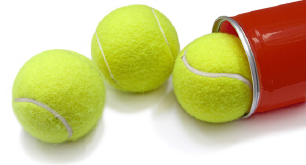This problem solving activity has a measurement focus.

Tennis balls are often sold in tubes of three.
Which is the greater: the height of the tube; the distance around the tube; or are they the same?
- Use the formula for the circumference and diameter of a sphere to solve a problem.
- Devise and use problem solving strategies to explore situations mathematically (be systematic, make a model).
In this problem students estimate in a situation that is familiar to them, but one that they may not have considered before. The result may not be geometrically intuitive as curved and straight lengths are compared.
The problem also provides a context for a practical measuring task that requires precision.
- String
- Eye tricks sheet
- Copymaster of the problem (English)
- Copymaster of the problem (Māori)
- A tennis ball tube (preferably one that is commerically-made)
- At least one tennis ball per group
The Problem
Tennis balls are often sold in tubes of three.
Which is the greater: the height of the tube; the distance around the tube; or are they the same?
Teaching Sequence
- Show the students the Eye Tricks sheet.
- Illustrate the problem with a tube or with 3 tennis balls.
- Ask students to vote on their choice of answer: height of the can or its circumference?
- Allow groups time to invent and carry out a method for solving the problem.
- Ask the students to write a statement to accompany their solution describing the mathematics that they used to solve the problem.
- Share solutions.
Extension
Generalise the result to other spheres. For example, use 3 basketballs, volleyballs, or soccer balls.
How big is the difference if you had a tube with three Earth’s in it?
Solution
Two solution methods are given.
The first way is the practical way of getting a tube of tennis balls and calculating the actual dimensions or constructing a tube of their own.
Option 1:
Make a (concrete) model.
Measure the height of a single ball or balance three on top of one another to measure the height. Measure the circumference of the tube, which is the same as the circumference of a single ball. Instead of measuring in units you can measure the circumference of the tube with a piece of string and then compare this directly with the height of three balls.
Note: The empirical result may not be convincing since the two measures are quite close.
Option 2:
Make a mathematical model.
Let the radius of a tennis ball be R. Then the height of the tube is 6R.
The circumference of the tube is the circumference of one ball, which is 2πR. 2π is approximately 6.28. Therefore, the circumference of the tube is 6.28R.
Hence, the circumference of the tube is greater than its height.
This appears to be counter-intuitive, as most students tend to vote for the height as being the greater of the two measures.
Solution to the Extension
It doesn’t matter what kind of sphere is used, the result is the same. It is the factors of 6 and 6.28 that make the difference. However, with larger spheres the difference is easier to see, especially if Option 1 was used to decide the issue.
A simple calculation with R = 1 and R = 10 shows this. Suppose that the units here are centimetres. It is easier to ‘see’ a difference of 2.8cm than a difference of 0.28cm.
If we used the Earth, where the equatorial radius is 6378 km, then the difference between the circumference and the height of any tube you could manufacture would be 0.28 x 6378 = 1785. It might be easier to see 1785 km.